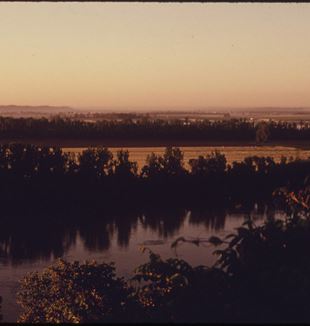
The Monk and the Captain
These are unexpected encounters with the Benedictines of Atchison, Kansas, a presence in this town since 1855. The meetings at Benedictine College, the birth of the CL community, and the Memores Domini house tell an exceptional story.Atchison, Kansas. Ten thousand souls in a small town whose true story was written and continues to be shaped by its Benedictine monks, here, along the shores of the Missouri River.
Atchison’s Benedictine College is home to one of the newest, youngest, and liveliest CL communities in the United States. I can still remember when I showed Fr. Giussani that little point on the map, the first outpost of the Movement in Kansas, the land of enormous farms and bison. The farms are still here–just look at the huge silos that still reign in the countryside, while the railroad dominates the center of town–but it’s pretty hard to find bison any more.
The Benedictines arrived here in 1855, following the German priest Fr. Henry Peter Lemcke, a Lutheran pastor who had converted to Catholicism. Two years later, while the political battle that would lead to the Civil War was heating up, the monks founded their abbey, and the next year, with the gift of a piece of land, established a parish and a school. Those were hard years; historians call that period bleeding Kansas, but the monks have always been builders of civilization.
Today, Benedictine College, with its 1,200 students, has also become the home of a beautiful CL community. How? The Lord’s ways are infinite, and the story of our little presence in Atchison documents this fully. Everything began with an improbable combination of characters: an Army captain stationed in Missouri, an administrative manager who lives in California, and a monk who came to Benedictine College for a degree but also found his vocation here, choosing to follow the tradition that still bears fruit today.
Captain Jones brought me here in 2002 to meet Fr. Meinrad and the other monks, animated by his certainty that the Benedictine monks couldn’t help but love the experience of the Movement. But one of the most curious discoveries of that trip was that Fr. Meinrad had been the college roommate of BJ Adamson, now with the San Diego CL community. In this providential weave of events (providential in the true sense: given by Providence!), I proposed a public presentation of The Religious Sense, the text we were working on at the time. So, in September 2002, with Fr. Meinrad totally enamored of this strange new thing he had encountered, Monsignor Albacete presented The Religious Sense in the college’s spacious auditorium and, from that moment on, the miraculous story of the Movement in the United States became “contagious” in other towns of Kansas as well. That day, among others present were Jerry Brungardt and John Traffas of Wichita, from the southeast of the state, a three-hour drive from Atchison. Jerry, a physician and father of a tribe of ten children, had learned about the presentation on the college’s website and had taken a day off to visit Benedictine, his alma mater with which he still had a strong bond. John had brought his son, soon to choose a university, to visit the campus.
In the past four years, many things have happened. Today, Jerry and John are the pillars of the Wichita community. Benedictine hosted presentations of the entire PerCorso Trilogy and also of Giussani’s The Psalms. After having welcomed the June 2004 “Communion and Liberation National Council” gathering, the relationship with the Movement has deepened even more, in particular with the Dean of Academics, Kimberly Shankman.
Today, a stone’s throw from the campus, there is a new Memores Domini house, with three friends who have made Benedictine College their daily fare: Salvatore (the first to arrive in September of that year), Business Professor and Director of the International Education Center; Steve, Library Director; and Daniele, Director of the Studies Abroad Program.
Recently, a discussion was organized after the Holy Father’s trip to Germany and his Regensburg lecture. With guest speaker Luca Grillo, a doctoral student in Classics at Princeton University, there were three professors from Benedictine: Dr. Macierowski, a philosopher; Dr. Taylor-Snyder, a historian; and Dr. Blosser, a theologian. By now, when the Movement proposes something at Benedictine, professors and students flock to it, curious and open.
But this time, for me, after over twelve years roving the great plains of the United States, the most moving thing was seeing the faces of the first two students to welcome us, freshmen Matt and Beth. I had met Matt when he was a little boy in the snowy cold of St. Cloud, Minnesota, where John and Ann, his parents and my dear friends of the early days, still live. Beth was a pre-teen when I saw her playing on the frozen lake in front of the Stokman home in Crosby, northern Minnesota.
Seeing a new community like the one in Atchison flower is a special grace. Seeing how a new community also becomes the home of young people raised in families that have embraced the charism of the Movement is an equally great miracle.